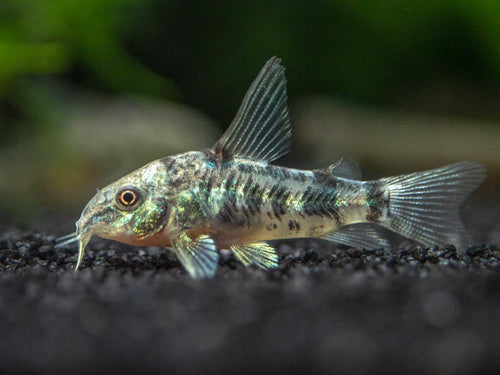Corydoras-Pepper
Corydoras-Pepper
check_circle Fast Shipping
check_circle Quality Products
check_circle Affordable Price
Reach out to us on ''available to order'' items via WhatsAp or email
Out of stock
Couldn't load pickup availability

Corydoras-Pepper
package_2
Product Description
Product Description
All our fish, shrimp and corals are bagged with fresh oxygen as well as a heat pack in winter.
When ordering livestock please select the box size and add it to your cart for accurate overnight (1-2 days) shipping costs. A small box can take 1-2 bags and a medium box 6 bags. One bag fits max 10 small (1-3cm) fish or max 2 medium (3-5cm) fish or max 1 large (>5cm) fish.
ONE SPECIES PER BAG. Eg: One bag of 10 neon tetra.
Pepper Cory (Corydoras paleatus)
Description:
-
Appearance:
- Body: Small, compact, and robust with a typical Corydoras shape—sturdy and slightly flattened.
- Color: Grayish or silver body with small black or dark gray spots scattered over the body, resembling pepper flakes. This pattern gives them their common name.
- Size: Typically grows to about 2-2.5 inches (5-6 cm) in length.
-
Behavior:
- Activity: Active and bottom-dwelling. Known for their curious and playful nature, often seen foraging through the substrate.
- Social Structure: Highly social; prefers to be kept in groups. Schooling behavior helps reduce stress and promotes natural activities.
Care Requirements:
-
Tank Size:
- Minimum of 20 gallons (76 liters) for a small group. Larger tanks are recommended to provide ample space and maintain good water quality.
-
Water Parameters:
- Temperature: 72-78°F (22-26°C).
- pH: 6.0-7.5.
- Hardness: Soft to moderately hard water. They thrive in slightly acidic to neutral water conditions.
- Filtration: Standard filtration is adequate. Ensure the filter does not create strong currents, as Corydoras prefer calmer waters.
-
Tank Setup:
- Substrate: Soft, smooth substrate such as sand or fine gravel. Avoid sharp or rough substrates to protect their sensitive barbels.
- Aquascaping: Provide hiding spots and structures like rocks, driftwood, and plants. These elements help create a comfortable environment and reduce stress.
- Lighting: Standard aquarium lighting is sufficient. They do not require special lighting but do best with moderate light levels.
-
Diet:
- Primary Food: Omnivorous; feed a varied diet including high-quality sinking pellets or tablets, as well as live or frozen foods such as bloodworms, brine shrimp, and daphnia.
- Supplemental Food: Offer occasional treats like blanched vegetables (e.g., zucchini, peas) to provide dietary variety and support overall health.
-
Behavioral Considerations:
- Compatibility: Best kept with other peaceful fish. Avoid aggressive or fin-nipping species. Suitable tank mates include small to medium-sized community fish.
- Social Behavior: Pepper Corydoras are schooling fish and should be kept in groups of at least 5-6 individuals to ensure they feel secure and exhibit natural behaviors.
-
Tank Maintenance:
- Water Changes: Perform regular water changes (20-30% weekly) to maintain water quality and reduce toxin buildup.
- Cleaning: Regularly clean the tank and remove any uneaten food or waste. Ensure the filtration system is functioning properly.
-
Health Care:
- Observation: Monitor for signs of stress or illness, such as changes in behavior, loss of appetite, or visible symptoms like discoloration or damaged barbels.
- Treatment: Maintain optimal water conditions and consult an aquarium professional if any health issues arise. Address any signs of disease or stress promptly to ensure the health of your fish.


